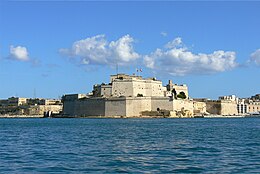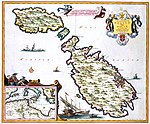
| History of Malta |
|---|
 |
|
|
The fortifications of Malta consist of a number of walled cities, citadels, forts, towers, batteries, redoubts, entrenchments and pillboxes. The fortifications were built over hundreds of years, from around 1450 BC to the mid-20th century, and they are a result of the Maltese islands' strategic position and natural harbours, which have made them very desirable for various powers.
The earliest known fortifications in Malta are defensive walls built around Bronze Age settlements. The Phoenicians, Romans and Byzantines built a number of defensive walls around important settlements, but very little remains of these survive today. By the late medieval period, the main fortifications on Malta were the capital Mdina, the Cittadella on Gozo, the Castrum Maris and a few coastal towers or lookout posts.
The fortifications of Malta were greatly improved while the islands were ruled by the Order of St. John between 1530 and 1798. The Hospitallers built new bastioned fortifications, such as the fortifications of Birgu and Valletta, and upgraded the medieval defences. By the end of the 18th century, Malta had extensive fortifications around the Grand Harbour and Marsamxett, as well as a coastal defence system consisting of towers, batteries, redoubts and entrenchments.
Following a brief French occupation, the islands fell under British rule in 1800. Between the 1870s and the 1900s a number of polygonal forts and batteries were built around Malta's coastline and along the Great Fault. In the 1930s and 1940s, Fort Campbell, a series of pillboxes and a number of anti-aircraft batteries were constructed, and these were the last fortifications to be built in Malta.
Malta's fortifications are considered to be among the best examples of military architecture anywhere in the world. Major General Whitworth Porter of the Royal Engineers, called Malta "the most powerful artificial fortress in the world" in his 1858 book A History of the Fortress of Malta.[1] In his 1893 book The Story of Malta, Maturin Murray Ballou wrote that "there is not a more complete system of fortifications extant, in any part of the world, than the cordon of defensive structures at Malta."[2]
The British architect Quentin Hughes referred to Malta's fortifications as "for sheer concentration and majesty quite unmatched",[3] while judge and historian Giovanni Bonello said that "nowhere in the world are fortifications more extensive, more impressive, more outstanding than they are in Malta."[4]
- ^ Porter, Whitworth (1858). A History of the Fortress of Malta. Valletta. p. iv.
{{cite book}}: CS1 maint: location missing publisher (link) - ^ Ballou, Maturin M. (1893). The Story of Malta. Boston: Houghton, Mifflin & Co. p. 57. Retrieved 4 December 2014.
- ^ "ERDF Fortifications Restoration, Malta". MilitaryArchitecture.com. 2 April 2010. Archived from the original on 15 January 2016. Retrieved 20 December 2014.
- ^ Bonello, Giovanni (18 November 2012). "Let's hide the majestic bastions". Times of Malta. Retrieved 21 November 2014.